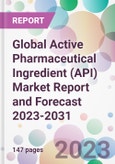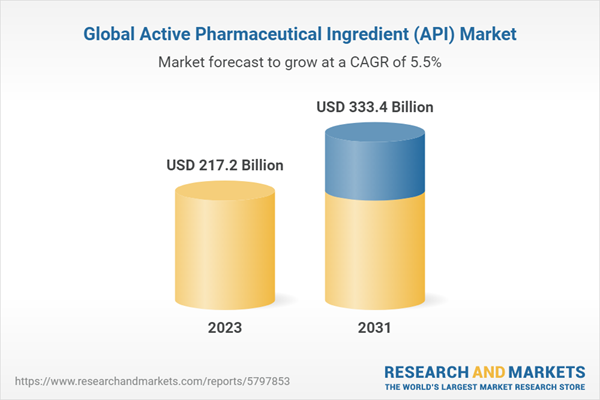The global active pharmaceutical ingredient market value was USD 205.9 billion in 2022, driven by the increasing prevalence of diseases across the globe. The market size is anticipated to grow at a CAGR of 5.5% during the forecast period of 2023-2031 to achieve a value of USD 333.4 billion by 2031.
APIs play a crucial role in the pharmaceutical industry, as they form the core component of drug formulations. They are responsible for the intended pharmacological action and desired therapeutic outcomes. APIs undergo rigorous testing and quality control measures to ensure their safety, efficacy, and compliance with regulatory standards.
The market for APIs is driven by factors such as the increasing prevalence of diseases, the growing demand for effective medications, and advancements in drug research and development. The pharmaceutical industry relies heavily on APIs to produce a wide range of drugs, including prescription medications, over-the-counter drugs, and generic drugs.
The demand for generic drugs is also driving the growth of the API market. Generic drug manufacturers rely on APIs to produce affordable alternatives to branded medications, contributing to cost savings for patients and healthcare systems.
The market is characterized by a diverse landscape of API manufacturers, ranging from large multinational companies to specialized contract manufacturing organizations (CMOs). Outsourcing API production to CMOs has become a common practice, enabling pharmaceutical companies to focus on their core competencies in drug formulation and commercialization.
Overall, the API market is dynamic and constantly evolving to meet the demands of the pharmaceutical industry. The market's growth is driven by the increasing need for effective medications, the expansion of generic drugs, advancements in technology, and the focus on quality and regulatory compliance. As the global population continues to grow and healthcare needs increase, the API market is expected to expand further in the coming years.
Active Pharmaceutical Ingredient: Introduction
Active Pharmaceutical Ingredients (APIs) are the primary active substances used in the formulation of pharmaceutical drugs. They are responsible for the therapeutic effects of the medication and are carefully selected based on their biological activity and safety profile. APIs can be obtained from natural sources, such as plants or animals, or synthesized through chemical processes.APIs play a crucial role in the pharmaceutical industry, as they form the core component of drug formulations. They are responsible for the intended pharmacological action and desired therapeutic outcomes. APIs undergo rigorous testing and quality control measures to ensure their safety, efficacy, and compliance with regulatory standards.
The market for APIs is driven by factors such as the increasing prevalence of diseases, the growing demand for effective medications, and advancements in drug research and development. The pharmaceutical industry relies heavily on APIs to produce a wide range of drugs, including prescription medications, over-the-counter drugs, and generic drugs.
Key Trends in the Active Pharmaceutical Ingredient Market
Some key trends in the active pharmaceutical ingredient market are:- Increasing demand for generic drugs: The rising cost of branded medications and the expiration of patents for many blockbuster drugs have fueled the demand for generic drugs. This has led to an increased focus on the production of cost-effective APIs to support the generic drug market
- Shift towards biologics and biosimilars: The development of biologics, including monoclonal antibodies and recombinant proteins, has gained significant momentum. APIs for biologics are produced using biotechnological processes, such as cell culture and genetic engineering. The market is also witnessing the emergence of biosimilars, which are similar versions of biologic drugs. This trend has created opportunities for API manufacturers specializing in biologics and biosimilars
- Increased regulatory scrutiny: Regulatory agencies, such as the U.S. Food and Drug Administration (FDA) and the European Medicines Agency (EMA), have strengthened their oversight of API manufacturing. They require manufacturers to comply with stringent quality control measures, good manufacturing practices (GMP), and quality assurance standards. This focus on quality and safety has influenced the API market, leading to improved manufacturing practices and increased investments in quality management systems
- Growing emphasis on sustainability: The pharmaceutical industry is increasingly recognizing the importance of sustainable practices in API manufacturing. There is a growing demand for environmentally friendly manufacturing processes, reduction of waste generation, and adoption of green chemistry principles. API manufacturers are investing in technologies and practices that minimize the environmental impact of API production
Active Pharmaceutical Ingredient Market Segmentations
Market Breakup by Molecule
- Small Molecule
- Large Molecule
Market Breakup by Type
- Innovative Active Pharmaceutical Ingredients
- Generic Active Pharmaceutical Ingredients
Market Breakup by Indications
- Acetaminophen
- Artemisinin
- Saxagliptin
- Sodium Chloride
- Ibuprofen Losartan Potassium
- Enoxaparin Sodium
- Rufinamide
- Naproxen
- Tamoxifen
- Others
Market Breakup by Type of Manufacturers
- Captive API Manufacturer
- Merchant API Manufacturer
Market Breakup by Potency
- Low to Moderate
- Potent to Highly Potent
Market Breakup by Therapeutic Applications
- Cardiology
- CNS & neurology
- Oncology
- Orthopedic
- Endocrinology
- Pulmonology
- Gastroenterology
- Nephrology
- Ophthalmology
- Other
Market Breakup by Distribution Channel
- Direct Tenders
- Retail Slaes
- Online Pharmacies
- Others
Market Breakup by Region
North America
- United States of America
- Canada
Europe
- United Kingdom
- Germany
- France
- Italy
- Others
Asia Pacific
- China
- Japan
- India
- ASEAN
- Australia
- Others
Latin America
- Brazil
- Argentina
- Mexico
- Others
Middle East and Africa
- Saudi Arabia
- United Arab Emirates
- Nigeria
- South Africa
- Others
Active Pharmaceutical Ingredient Market Scenario
The global API (Active Pharmaceutical Ingredient) market plays a critical role in the pharmaceutical industry by providing the essential components necessary for the formulation and production of medications. The API market is driven by several factors, including the increasing prevalence of diseases, the demand for effective medications, and the growing generic drug market. The rising burden of chronic conditions, such as cardiovascular diseases, diabetes, and cancer, has fuelled the demand for APIs that can address these health challengesThe demand for generic drugs is also driving the growth of the API market. Generic drug manufacturers rely on APIs to produce affordable alternatives to branded medications, contributing to cost savings for patients and healthcare systems.
The market is characterized by a diverse landscape of API manufacturers, ranging from large multinational companies to specialized contract manufacturing organizations (CMOs). Outsourcing API production to CMOs has become a common practice, enabling pharmaceutical companies to focus on their core competencies in drug formulation and commercialization.
Overall, the API market is dynamic and constantly evolving to meet the demands of the pharmaceutical industry. The market's growth is driven by the increasing need for effective medications, the expansion of generic drugs, advancements in technology, and the focus on quality and regulatory compliance. As the global population continues to grow and healthcare needs increase, the API market is expected to expand further in the coming years.
Active Pharmaceutical Ingredient Market: Competitor Landscape
The key features of the market report include patent analysis, grants analysis, clinical trials analysis, funding and investment analysis, partnerships, and collaborations analysis by the leading key players. The major companies in the market are as follows:- AstraZeneca
- Bristol-Myers Squibb
- Eli Lilly and Company
- F. Hoffmann-La Roche AG
- GlaxoSmithKline
- Johnson & Johnson
- Merck & Co., Inc
- Novartis International AG
- Pfizer Inc
- Sanofi
- Takeda Pharmaceutical Company Limited
- Celgene Corporation
- Amgen Inc
- Gilead Sciences, Inc
- Bayer AG
- AbbVie Inc
- Regeneron Pharmaceuticals, Inc
- Genentech
- Seattle Genetics, Inc
- Aimmune Therapeutics
Table of Contents
1 Preface
3 Global Active Pharmaceutical Ingredient (API) Market Overview
4 Global Active Pharmaceutical Ingredient (API) Market Landscape
5 Global Active Pharmaceutical Ingredient (API) Market Dynamics
6 Global Active Pharmaceutical Ingredient (API) Market Segmentation
7 North America Active Pharmaceutical Ingredient (API) Market
8 Europe Active Pharmaceutical Ingredient (API) Market
9 Asia Pacific Active Pharmaceutical Ingredient (API) Market
10 Latin America Active Pharmaceutical Ingredient (API) Market
11 Middle East and Africa Active Pharmaceutical Ingredient (API) Market
12 Patent Analysis
13 Grants Analysis
14 Funding Analysis
15 Partnership and Collaborations Analysis
16 Regulatory Framework
17 Supplier Landscape
18 Global Active Pharmaceutical Ingredient (API) Market - Distribution Model (Additional Insight)
20 Company Competitiveness Analysis (Additional Insight)
21 Payment Methods (Additional Insight)
Companies Mentioned
- Astrazeneca
- Bristol-Myers Squibb
- Eli Lilly and Company
- F. Hoffmann-La Roche AG
- GlaxoSmithKline
- Johnson & Johnson
- Merck & Co. Inc.
- Novartis International AG
- Pfizer Inc.
- Sanofi
- Takeda Pharmaceutical Company Limited
- Celgene Corporation
- Amgen Inc.
- Gilead Sciences, Inc.
- Bayer AG
- Abbvie Inc.
- Regeneron Pharmaceuticals, Inc.
- Genentech
- Seattle Genetics, Inc.
- Aimmune Therapeutics
Methodology

LOADING...
Table Information
| Report Attribute | Details |
|---|---|
| No. of Pages | 147 |
| Published | April 2023 |
| Forecast Period | 2023 - 2031 |
| Estimated Market Value ( USD | $ 217.2 Billion |
| Forecasted Market Value ( USD | $ 333.4 Billion |
| Compound Annual Growth Rate | 5.5% |
| Regions Covered | Global |
| No. of Companies Mentioned | 20 |









